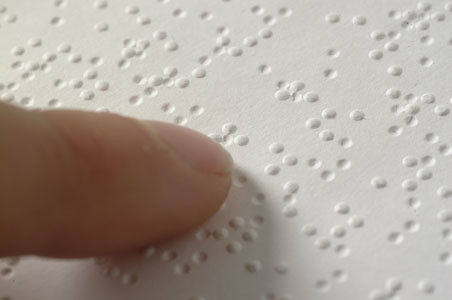Deaf and blind people fall into a broader category known as sensory impaired persons. Sensory impairments of this type actually fall into three different  typologies, those who have blindness, those who have deafness, and those who have both blindness and deafness known as the deaf-blind. For each of these categories of visual impairment, the individuals have differing learning needs; however, some facets of educating blind and deaf people remain the same across all of these types of sensory impairment.
typologies, those who have blindness, those who have deafness, and those who have both blindness and deafness known as the deaf-blind. For each of these categories of visual impairment, the individuals have differing learning needs; however, some facets of educating blind and deaf people remain the same across all of these types of sensory impairment.
Instructions
Baseline
- Identify the condition of blindness, deafness, or the combination deaf-blindness early on to provide a baseline for educational opportunities that can best serve the needs of the individual who has a sensory impairment as indicated at the Division on Visual Impairments website.
- Identify the principles of education that pertain to the form of sensory impairment of the student you plan to procure education for. Educating blind individuals, for example, under the broader category of vision-impaired persons, as well as educating deaf-blind persons both have a set of principles that places a value on professional partnerships between educators and families. Educating both blind and deaf-blind persons also operates under a set of principles that involve individual assessment and a choice of different forms of learning as mentioned both at the Division on Visual Impairments and the Ebility websites.
- Acquire the necessary skills to enable you to communicate with the individual who has a sensory impairment. Family members as well as educators need to learn such communication techniques as finger spelling and an appropriate form of sign language in the case of deaf of deaf-blind persons because these individuals must communicate in a tactile way rather through auditory communication. Blind individuals who have no hearing impairment can, however, learn through audio communication but must use another communication method to learn from written materials such as Braille or the use of recorded reading of texts. Educate the blind, deaf, or deaf-blind person, if a child, in the home as well as through a qualified educational program (refs 1 and 2).
- Investigate the available programs locally to the sensory impaired individual and assess which program or programs best suit the way in which the individual blind, deaf, or deaf-blind person prefers to learn. All educators working with sensory-impaired individuals must have qualifications in the kinds of communication necessary to teach sensory-impaired individuals as well as having the qualifications required for any teaching position as mentioned at the Division on Visual Impairments, the Ebility, and the Baylor university website.
- Determine the enrollment criteria for the educational program you have identified as the best fit for the deaf-blind person you are procuring education for. Obtain any registration or application forms and provide the completed forms to the program. Also obtain from the program’s support personnel, such as registration personnel, at this same time information about any financial support programs available to assist in the payment of any tuition involved.
- Continue to provide support of the sensory impaired individual’s education through a formal educational program by providing ongoing work in the home with educational materials. Blind individuals with no hearing impairment may also have access later in their educational progression to individuals who can read to them in person from textbooks through state-funded programs.